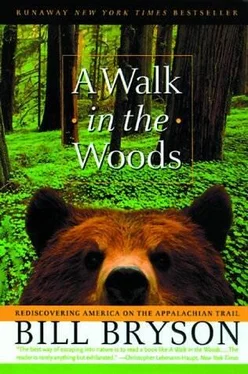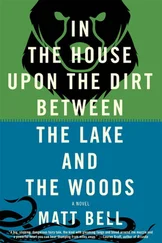Bill Bryson - A Walk In The Woods
Здесь есть возможность читать онлайн «Bill Bryson - A Walk In The Woods» весь текст электронной книги совершенно бесплатно (целиком полную версию без сокращений). В некоторых случаях можно слушать аудио, скачать через торрент в формате fb2 и присутствует краткое содержание. Жанр: Современная проза, на английском языке. Описание произведения, (предисловие) а так же отзывы посетителей доступны на портале библиотеки ЛибКат.
- Название:A Walk In The Woods
- Автор:
- Жанр:
- Год:неизвестен
- ISBN:нет данных
- Рейтинг книги:4 / 5. Голосов: 1
-
Избранное:Добавить в избранное
- Отзывы:
-
Ваша оценка:
- 80
- 1
- 2
- 3
- 4
- 5
A Walk In The Woods: краткое содержание, описание и аннотация
Предлагаем к чтению аннотацию, описание, краткое содержание или предисловие (зависит от того, что написал сам автор книги «A Walk In The Woods»). Если вы не нашли необходимую информацию о книге — напишите в комментариях, мы постараемся отыскать её.
A Walk In The Woods — читать онлайн бесплатно полную книгу (весь текст) целиком
Ниже представлен текст книги, разбитый по страницам. Система сохранения места последней прочитанной страницы, позволяет с удобством читать онлайн бесплатно книгу «A Walk In The Woods», без необходимости каждый раз заново искать на чём Вы остановились. Поставьте закладку, и сможете в любой момент перейти на страницу, на которой закончили чтение.
Интервал:
Закладка:
A signficant fraction of thru-hikers reach Katahdin, then turn around and start back to Georgia. They just can’t stop walking, which kind of makes you wonder. In fact, the more you read about thru-hikers the more you end up being filled with a kind of wonder. Take Bill Irwin, the blind man. After his hike he said: “I never enjoyed the hiking part. It was something I felt compelled to do. It wasn’t my choice.” Or David Horton, the ultra-runner who set the speed record in 1991. By his own account, he became “a mental and emotional wreck” and spent most of the period crossing Maine weeping copiously. (Well, then why do it?) Even good old Earl Shaffer ended up as a recluse in the backwoods of Pennsylvania. I don’t mean to suggest that hiking the AT drives you potty, just that it takes a certain kind of person to do it.
And how did I feel about giving up the quest when a granny in sneakers, a human beachball named Woodrow, and over 3,990 others had made it to Katahdin? Well, pretty good, as a matter of fact. I was still going to hike the Appalachian Trail; I just wasn’t going to hike all of it. Katz and I had already walked half a million steps, if you can believe it. It didn’t seem altogether essential to do the other 4.5 million to get the idea of the thing.
So we rode to Knoxville with our comical cabdriver, acquired a rental car at the airport, and found ourselves, shortly after midday, heading north out of Knoxville through a half-remembered world of busy roads, dangling traffic signals, vast intersections, huge signs, and acre upon acre of shopping malls, gas stations, discount stores, muffler clinics, car lots, and all the rest. Even after a day in Gatlinburg, the transition was dazzling. I remember reading once how some Stone Age Indians from the Brazilian rain forest with no knowledge or expectation of a world beyond the jungle were taken to São Paulo or Rio, and when they saw what it contained-the buildings, the cars, the passing airplanes-and how thoroughly at variance it was with their own simple lives, they wet themselves, lavishly and in unison. I believe I had some idea how they felt.
It is such a strange contrast. When you’re on the AT, the forest is your universe, infinite and entire. It is all you experience day after day. Eventually it is about all you can imagine. You are aware, of course, that somewhere over the horizon there are mighty cities, busy factories, crowded freeways, but here in this part of the country, where woods drape the landscape for as far as the eye can see, the forest rules. Even the little towns like Franklin and Hiawassee and even Gatlinburg are just way stations scattered helpfully through the great cosmos of woods.
But come off the trail, properly off, and drive somewhere, as we did now, and you realize how magnificently deluded you have been. Here, the mountains and woods were just backdrop-familiar, known, nearby, but no more consequential or noticed than the clouds that scudded across their ridgelines. Here the real business was up close and on top of you: gas stations, Wal-Marts, Kmarts, Dunkin Donuts, Blockbuster Videos, a ceaseless unfolding pageant of commercial hideousness.
Even Katz was unnerved by it. “Jeez, it’s ugly,” he breathed in wonder, as if he had never witnessed such a thing before. I looked past him, along the line of his shoulder, to a vast shopping mall with a prairie-sized parking lot, and agreed. It was horrible. And then, lavishly and in unison, we wet ourselves.
Chapter 10
There is a painting by Asher Brown Durand called “Kindred Spirits,” which is often reproduced in books when the subject turns to the American landscape in the nineteenth century. Painted in 1849, it shows two men standing on a rock ledge in the Catskills in one of those sublime lost world settings that look as if they would take an expedition to reach, though the two figures in the painting are dressed, incongruously, as if for the office, in long coats and plump cravats. Below them, in a shadowy chasm, a stream dashes through a jumble of boulders. Beyond, glimpsed through a canopy of leaves, is a long view of gorgeously forbidding blue mountains. To right and left, jostling into frame, are disorderly ranks of trees, which immediately vanish into consuming darkness.
I can’t tell you how much I would like to step into that view. The scene is so manifestly untamed, so full of an impenetrable beyond, as to present a clearly foolhardy temptation. You would die out there for sure-shredded by a cougar or thudded with a tomahawk or just left to wander to a stumbling, confounded death. You can see that at a glance. But never mind. Already you are studying the foreground for a way down to the stream over the steep rocks and wondering if that notch ahead will get you through to the neighboring valley. Farewell, my friends. Destiny calls. Don’t wait supper.
Nothing like that view exists now, of course. Perhaps it never did. Who knows how much license these romantic johnnies took with their stabbing paintbrushes? Who, after all, is going to struggle with an easel and campstool and box of paints to some difficult overlook, on a hot July afternoon, in a wilderness filled with danger, and not paint something exquisite and grand?
But even if the preindustrialized Appalachians were only half as wild and dramatic as in the paintings of Durand and others like him, they must have been something to behold. It is hard to imagine now how little known, how full of possibility, the world beyond the eastern seaboard once was. When Thomas Jefferson sent Lewis and Clark into the wilderness, he confidently expected them to find woolly mammoths and mastodons. Had dinosaurs been known, he would almost certainly have asked them to bring him home a triceratops.
The first people to venture deep into the woods from the East (the Indians, of course, had got there perhaps as much as 20,000 years before them) weren’t looking for prehistoric creatures or passages to the West or new lands to settle. They were looking for plants. America’s botanical possibilities excited Europeans inordinately, and there was both glory and money to be made out in the woods. The eastern woods teemed with flora unknown to the Old World, and there was a huge eagerness, from scientists and amateur enthusiasts alike, to get a piece of it. Imagine if tomorrow a spaceship found a jungle growing beneath the gassy clouds of Venus. Think what Bill Gates, say, would pay for some tendriled, purply lobed piece of Venusian exotica to put in a pot in his greenhouse. That was the rhododendron in the eighteenth century-and the camellia, the hydrangea, the wild cherry, the rudbeckia, the azalea, the aster, the ostrich fern, the catalpa, the spice bush, the Venus flytrap, the Virginia creeper, the euphorbia. These and hundreds more were collected in the American woods, shipped across the ocean to England and France and Russia, and received with greedy keenness and trembling fingers.
It started with John Bartram (actually, it started with tobacco, but in a scientific sense it started with John Bartram), a Pennsylvania Quaker, born in 1699, who grew interested in botany after reading a book on the subject and began sending seeds and cuttings to a fellow Quaker in London. Encouraged to seek out more, he embarked on increasingly ambitious journeys into the wilderness, sometimes traveling over a thousand miles through the rugged mountains. Though he was entirely self-taught, never learned Latin, and had scant understanding of Linnaean classifications, he was a prize plant collector, with an uncanny knack for finding and recognizing unknown species. Of the 800 plants discovered in America in the colonial period, Bartram was responsible for about a quarter. His son William found many more.
Before the century was out, the eastern woods were fairly crawling with botanists-Peter Kalm, Lars Yungstroem, Constantine Samuel Rafinesque-Schmaltz, John Fraser, André Michaux, Thomas Nuttall, John Lyon, and others pretty much beyond counting. There were so many people out there, hunting so competetively, that it is often not possible to say with any precision who discovered what. Depending on which source you consult, Fraser found either 44 new plants or 215, or something in between. One of his uncontested discoveries was the fragrant southern balsam, the Fraser fir, so characteristic of the high ranges of North Carolina and Tennessee, but it bears his name only because he scrambled to the top of Clingmans Dome just ahead of his keen rival Michaux.
Читать дальшеИнтервал:
Закладка:
Похожие книги на «A Walk In The Woods»
Представляем Вашему вниманию похожие книги на «A Walk In The Woods» списком для выбора. Мы отобрали схожую по названию и смыслу литературу в надежде предоставить читателям больше вариантов отыскать новые, интересные, ещё непрочитанные произведения.
Обсуждение, отзывы о книге «A Walk In The Woods» и просто собственные мнения читателей. Оставьте ваши комментарии, напишите, что Вы думаете о произведении, его смысле или главных героях. Укажите что конкретно понравилось, а что нет, и почему Вы так считаете.












